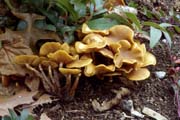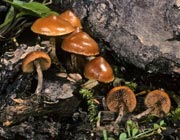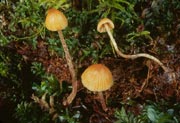
Steve Trudell

Kit Scates Barnhart

Michael Beug
The most important work on the genus Galerina in the Pacific Northwest was written by A.H. Smith and Rolf Singer in 1964, A Monograph on the Genus Galerina Earle.
This monograph has now been made available online by the University of Michigan at
http://quod.lib.umich.edu/cgi/t/text/text-idx?c=fung1tc;cc=fung1tc;view=toc;idno=AGK0805.0001.001
Easier to use is the version on www.mykoweb.com
http://www.mykoweb.com/systematics/literature/A%20Monograph%20on%20the%20Genus%20Galerina.pdf
The keys and descriptions it contains should be consulted for detailed work.
Smith and Singer presented some 200 species worldwide, and collections of about 80 of these were examined from the Pacific Northwest (in this case meaning British Columbia, Washington, Oregon, or Idaho). As a group these are commonly encountered, primarily associated with living mosses, probably as saprophytes on dead parts. Others are confined to wood or other plant debris. Identification of Galerina species in the field without the aid of the microscope is often impossible.
Molecular research published in 2005 (Gulden et al.) supports four main clades of Galerina, corresponding roughly to previous subgeneric concepts. One of the four appears more closely related to Gymnopilus than to the other Galerina clades, and a few Galerina species appear more closely related to other dark spored mushrooms. As with many mushrooms groups, ongoing reorganization and renaming is expected in future.
The particularly poisonous Galerina marginata complex, which includes Galerina autumnalis, deserves special mention. Some members of the complex have been shown to have Amanita-type toxins. They have occasionally been mistaken by inexpert mushroom hunters for hallucinogenic Psilocybe species, with serious medical consequences. Unlike most Galerina species, members of this complex these grow on wood rather than moss, and the cap is convex rather than bluntly conical. There is often a thin annulus on the stem. Arora gives the distinguishing characters of Galerina autumnalis (in relation to other little brown mushrooms) as small size and thin stem (but in areas of high rainfall overgrown specimens occur), the veil usually but not always forming a thin, whitish, superior annulus (ring), rusty-brown spores, and growth on wood (which may however be buried or very decayed and not obvious). The cap is “viscid when moist, dark brown to yellow-brown or tawny, fading to tan or yellowish as it dries; margin translucent-striate when moist”. The viscid cap of Galerina autumnalis served as a distinguishing feature from Galerina marginata which was said to have a moist cap, but the distinction may be artificial. Gulden et al. (2001) investigated molecular characters in the Galerina marginata complex and concluded from these characters and for other reasons that Galerina autumnalis (Peck) A.H. Sm. & Singer, G. unicolor (Vahl) Singer, G. oregonensis A.H. Sm., and G. venenata A.H. Sm. are all synonyms of Galerina marginata (Batsch) Kühner.
FRUITBODY small. CAP bell-shaped, conical, or hemispherical-convex, fairly thin, ocher to rust-yellow or rust-brown, dry to viscid (when moist), usually smooth, usually striate on margin when moist. GILLS typically adnexed to adnate. STIPE slender, brittle. VEIL present or absent, sometimes forming an annulus. HABITAT particularly on moss beds, but some species on organic debris, humus, or wood. SPORE DEPOSIT ochraceous to rusty brown. MICROSTRUCTURES spores in most species having a distinct more or less smooth area just above the apiculus on the face view, on the rest of the spore warty or smooth, mostly lacking an apical pore; cheilocystidia and sometimes pleurocystidia present; cap cuticle usually filamentous.
Galerina species can be confused with brown Mycena species, which have white spore deposit. Conocybe species can be similar. They are less likely to be viscid and translucent-striate, spores are smooth and cap cuticle is cellular. Tubaria species have slightly decurrent gills and a convex to flat or slightly depressed cap; however, these characters can be found in some Galerina species and the Tubaria species are best learned individually.
Galerina marginata Steve Trudell |
Galerina "autumnalis" Kit Scates Barnhart | Galerina species Michael Beug |
- END -